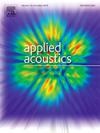Reverb hiding: A new framework for audio steganography
IF 3.4
2区 物理与天体物理
Q1 ACOUSTICS
引用次数: 0
Abstract
In the last decades, a lot of new approaches have been developed for audio steganography. However, most of these studies ignore musical hearing. In this paper, we proposed a new framework for hiding data in audio using the reverb effect, which is one of the time-dependent effects in music production. Reverb is an audio effect in music production that creates an artificial atmosphere that simulates what could be found in a natural setting such as a large hall, stadium, etc. The impulse response of the related environment is convolved with an audio file in a studio environment. This study proposes embedding secret data in audio signals with the reverb effect. The secret message is embedded into the impulse response of the natural environment and then the audio signal is reverbed with this impulse response. The original and reverberated audios are again blended for parallel processing, resulting in stego-audio. In the data extraction stage, firstly the fully reverberated audio is obtained from stego-audio which was blended with the original (dry) audio. Then, the reverberated audio file is deconvolved with the dry audio again, and the stego impulse response is obtained.
Existing studies of audio steganography such as echo hiding are common techniques used in music production but have a significant impact on hearing. The proposed reverb hiding is done with much more complex parameters, so the stego-audio is more compatible with real-life applications. The reverb-hiding achieves superior PSNR results for different sizes of the secret message. The proposed method evaluated in terms of oscillograms, frequency spectrum analysis, spectrograms, cepstrogram analysis, histogram analysis, and autocorrelation analysis. The experimental results are also compared with six different existing audio-tech methods. The proposed reverb-hiding method significantly impacts the trade-off between capacity and imperceptibility, as indicated by the results.
混响隐藏:音频隐写的新框架
在过去的几十年里,许多新的音频隐写方法被开发出来。然而,这些研究大多忽略了音乐听力。在本文中,我们提出了一个利用混响效果隐藏音频数据的新框架,混响效果是音乐制作中与时间相关的效果之一。混响是音乐制作中的一种音频效果,它创造了一种人工氛围,模拟了在大厅、体育场等自然环境中可以找到的东西。相关环境的脉冲响应与演播室环境中的音频文件进行卷积。本研究提出利用混响效果在音频信号中嵌入秘密数据。秘密信息被嵌入到自然环境的脉冲响应中,然后音频信号与这个脉冲响应混响。原始和混响的音频再次混合并行处理,导致隐音音频。在数据提取阶段,首先从原始音频(干音频)混音后得到充分混响的混响音频。然后,将混响音频文件与干燥音频文件进行反卷积,得到隐进脉冲响应。回声隐藏等音频隐写技术是音乐制作中常用的技术,但对听力有很大影响。所提出的混响隐藏是用更复杂的参数完成的,因此隐写音频与现实生活中的应用更加兼容。对于不同大小的秘密信息,混响隐藏实现了优越的PSNR结果。该方法从示波图、频谱分析、频谱图、倒图分析、直方图分析和自相关分析等方面进行了评价。实验结果还与现有的六种不同的音频技术方法进行了比较。结果表明,所提出的混响隐藏方法显著影响了容量和不可感知性之间的权衡。
本文章由计算机程序翻译,如有差异,请以英文原文为准。
求助全文
约1分钟内获得全文
求助全文
来源期刊

Applied Acoustics
物理-声学
CiteScore
7.40
自引率
11.80%
发文量
618
审稿时长
7.5 months
期刊介绍:
Since its launch in 1968, Applied Acoustics has been publishing high quality research papers providing state-of-the-art coverage of research findings for engineers and scientists involved in applications of acoustics in the widest sense.
Applied Acoustics looks not only at recent developments in the understanding of acoustics but also at ways of exploiting that understanding. The Journal aims to encourage the exchange of practical experience through publication and in so doing creates a fund of technological information that can be used for solving related problems. The presentation of information in graphical or tabular form is especially encouraged. If a report of a mathematical development is a necessary part of a paper it is important to ensure that it is there only as an integral part of a practical solution to a problem and is supported by data. Applied Acoustics encourages the exchange of practical experience in the following ways: • Complete Papers • Short Technical Notes • Review Articles; and thereby provides a wealth of technological information that can be used to solve related problems.
Manuscripts that address all fields of applications of acoustics ranging from medicine and NDT to the environment and buildings are welcome.
 求助内容:
求助内容: 应助结果提醒方式:
应助结果提醒方式:


